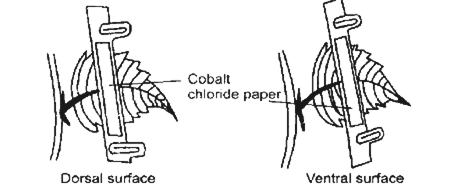Given below is an experimental setup to demonstrate a particular process. Study the same and answer the questions which follow:
(i) Name the physiological process being studied.
(ii) Explain the process mentioned above.
(iii)What is the aim of the above experiment?
(iv)What would you observe in the experimental setup after an hour? Give a reason to support your answer.
(v) Mention any three adaptations in plants to overcome the physiological process mentioned in (i) above.
(i) Transpiration.
(ii) Transpiration is a process by which plants lose water in the form of water vapour,
through the aerial parts of the plant. Transpiration helps plants to maintain their temperature. It also cools the regions around the plants.
(iii)The aim of the experiment is to demonstrate that more transpiration occurs from
the lower surface of the leaf.
(iv)After an hour, both the cobalt chloride papers attached to the upper as well as the
lower surface of the leaf turn pink. However, the pink colour of the paper attached
to the lower surface is darker as compared to the paper attached to the upper
surface of the leaf. This is because the number of stomata on the lower surface is
more than the number of stomata on the upper surface of the leaf.
(v) Adaptations in plants to overcome the process of transpiration:
a. Presence of a thick cuticle.
b. Reduced exposed surfaces as the leaves get wavy, rolled or folded.
c. Leaves may be shed or modified into spines.
Study the diagram given below and answer the questions which follow. The diagram is depicting a defect of the human eye.
(i) Identify the defect shown in the diagram.
(ii) Give two possible reasons for the above defect.
(iii)Draw a neat labelled diagram to show how the above defect can be rectified.The diagram given below shows the cross-section of two kinds of blood vessels.
(i) Identify the blood vessels, A and B. In each case, give a reason to support your answer.
(ii) Name the parts labelled 1 and 2.
(iii)When are the sounds ‘LUBB’ and ‘DUB’ produced during a heartbeat?
(iv)Name the blood vessel which
(1) begins and ends in capillaries.
(2) supplies blood to the walls of the heart.(a) A homozygous plant having round (R) and yellow (Y) seeds is crossed with a homozygous plant having wrinkled (r) and green (y) seeds.
(i) Give the scientific name of the plant on which Mendel conducted his hybridization experiments.
(ii) Give the genotype of the F1 generation.
(iii)Give the dihybrid phenotypic ratio and the phenotype of the offspring of F2 generation when two plants of the F1 generation are crossed.
(iv)Name and state the law which explains dihybrid ratio.
(v) Give the possible combinations of gametes which can be obtained from F1 hybrid.
The diagram given below shows the excretory system in humans. Study the same and answer the questions.
(i) Name the parts labelled 1, 2, 3 and 4.
(ii) Give the main function of the parts labelled 5, 6, 7 and 8.
(iii) Name the endocrine gland which could be added in the diagram and state its location/position.
Given below is a diagram of the cell as seen under the microscope after having been placed in a solution.
(i) What is the technical term used for the state/condition of the cell shown above?
(ii) Give the technical term for the solution in which the cell was placed.
(iii)Name the parts numbered 1 to 4.
(iv)Is the cell given above a plant cell or an animal cell? Give two reasons in support of your answer as evident from the diagram.
(v) What would you do to bring this cell back to its original condition?
Study the diagram given below and answer the questions which follow:
(i) Name the part labelled A. Name any two hormones produced by part A.
(ii) What happens to the part labelled B:
(1) If fertilisation takes place.
(2) If fertilisation does not take place.
(iii)Where does fertilisation occur?
(iv)Draw a neat diagram of the human sperm as seen under high magnification and label the following parts:
(1) Acrosome
(2) MitochondriaDifferentiate between the following on the basis of what is mentioned in the brackets:
i. Natality and mortality (definition).
ii. Stoma and Stroma (structure)
iii. Acromegaly and Cretinism ( Symptoms)
iv. Transpiration and Guttation ( Structures involved)
v. Diabetes insipidus and Diabetes Mellitus (cause)